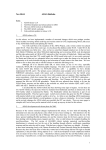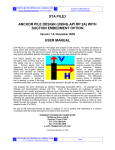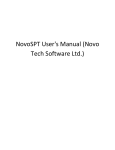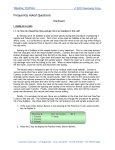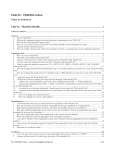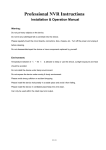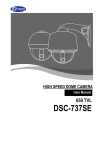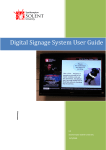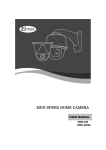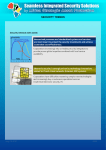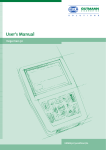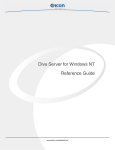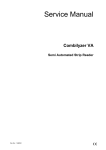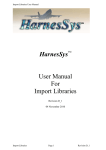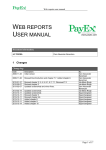Download foundation analysis and design - HCMUT
Transcript
FOUNDATION ANALYSIS AND
DESIGN
Fifth Edition
Joseph E. Bowles, RE., S.E.
Consulting Engineer/Software
Engineering
Consultant
Computer Software
Peoria, Illinois
The McGraw-Hill Companies, Inc.
New York St. Louis San Francisco Auckland Bogota Caracas
Lisbon London Madrid Mexico City Milan Montreal New Delhi
San Juan Singapore Sydney Tokyo Toronto
McGraw-Hill
A Division of The McGraw-Hill Companies
FOUNDATION ANALYSIS AND DESIGN
International Edition 1997
Exclusive rights by McGraw-Hill Book Co - Singapore, for manufacture and export. This book
cannot be re-exported from the country to which it is sold by McGraw-Hill. The International
Edition is not available in North America.
Copyright © 1996, 1988, 1982, 11977, 1968 by The McGraw-Hill Companies, Inc. All rights
reserved. Except as permitted under the Copyright Act of 1976, no part of this publication may be
reproduced or distributed in any form or by any means, or stored in a database or retrieval system,
without the prior written consent of the McGraw-Hill Companies, Inc., including, but not limited to,
in any network or other electronic storage or transmission, or broadcast for distance learning.
Some ancillaries, including electronic and print components, may not be available to customers
outside the United States.
10 09 08 07
20 09 08 07 06
BJE
Library of Congress Cataloging-in-Publication Data
Bowles, Joseph E.
Foundation analysis and design / Joseph E. Bowles. - 5 t h ed.
p.
cm.
Includes index.
ISBN 0-07-912247-7 (set)
1. Foundations. 2. Soil mechanics. I. Title.
TA775.B63 1996
624.'5—dc20
95-37880
TEXT DISCLAIMER
Although every effort has been made to interpret the references cited correctly, there is no warranty
express or implied that the interpretation is correct. If there is a question of whether the
interpretation has been correctly made, the reader should consult the appropriate reference. There is
also no warranty that every equation in the text has been correctly typeset. There are inevitably a
few errors between the time equations re first written and when they get into print. It is the user's
responsibility to check the results of any equation that has been used and, if the results do not seem
reasonable, to use the textbook explanation (or original reference) to see if the equation can be
derived. To catch equation errata the author, in addition to presenting the equation, has usually used
the equation in an example.
COMPUTER PROGRAM DISCLAIMER
Neither the publisher nor the author warrants the included programs to execute other that the
displayed output if the data are correctly entered into the computer. Any use of these programs to
solve problem other that those displayed or for which data sets are provided is the sole responsibility
of the user. This includes making a correct problem model, obtaining the necessary input data
(including any estimated values), and interpreting the output.
When ordering this title, use ISBN 0-07-118844-4
Printed in Singapore
PREFACE
This fifth edition continues the format of the previous four editions for providing current
state-of-art (SOA) and state-of-practice (SOP) methods in Foundation Engineering. From
author-user interaction I have concluded that SOP tends to lag SOA on the average of about
10 years. There is a range, however, where a few larger organizations are at the cutting edge
of technology and many—particularly the smaller firms—are at varying intermediate stages.
This textbook, which is also widely used as a practitioner's reference, includes SOP
material but with major emphasis on SOA. The latter is accomplished by including a mix
of practice, "how to," and latest suggested design/analysis methodology. This produces a
text compatible with the general goals of the American Society of Civil Engineers (ASCE)
and other professional organizations, which have determined that technical graduates have a
postgraduate period of only 5 to 7 years before obsolescence becomes a factor in their practice.
Design methods tend to vary between geographic regions, partly from instructors' influences and partly because there are few "design absolutes." As a consequence it is necessary
to include the generally accepted alternative methods but to temper these with recommendations and suggestions on their use. This allows the user access to regional differences and
provides "averaged" design results or the option to select the most appropriate alternative on
a site-specific basis. Although these comments may appear overly practice-oriented, the fact
is that the student must be aware of these real-world conflicts, geographical differences, and
alternatives so as to be productive upon graduation.
This book emphasizes computer methods and the Finite-Element Method (FEM), involving matrix methods given in the previous editions, to reflect the widespread use of the
personal computer and of the FEM in practice. Be aware, however, that the finite-element
method does not have a unique definition. To some practitioners it is any mathematical representation of the continua (beams, plates, or solids) using discrete (or finite) elements. To
other practitioners the FEM definition is reserved only for modeling the soil mass and the interfacing structural elements—sometimes this is called "soil-structure interaction" modeling.
In this textbook the former definition is used, for it is the one that is most widely practiced
and given in most textbooks devoted solely to the FEM.
This textbook gives sufficient background theory for a FEM model so that the average
user should have little difficulty using this method for design/analysis of those types of soilstructure interfacings used herein. It does make the modest assumption that most students at
the level of this textbook have been exposed to some FEM and matrix methodology in statics;
elementary structures; and the required university-level math courses. As a further aid there
are computer programs (already compiled on an accompanying diskette) so the user does not
have to become involved in FEM programming to use the methodology given.
WHAT'S NEW
This book has been substantially revised to include appropriate new material and expanded
discussion of previous material. A large number of figures have been modified and several
new ones added. I was able to do this with only a small increase in the total page count
since providing the computer programs on diskette freed for text pages that had been used
for program listings. Specifically these changes include but are not limited to the following:
a. Revision of text examples and problems so they are all in SI. Only two or three exceptions
occur in examples that were originally published in Fps and for which a user would have
to put forth too much effort to reconvert the material for verification.
b. I added five additional computer programs to the basic package so there are now 16 on
the diskette. Nearly all of the data sets for the examples used in the textbook that can be
used with the included programs are also on the program diskette. These will be extremely
valuable for users to obtain computer output quickly in a more readable size. A number
of problems at the ends of chapters are based on the user making a copy of the included
data file for editing and execution.
c. I have revised the problems so that if an applicable computer program is on the diskette it
will have to be used.
d. I have corrected several equations and figures from the previous edition.
e. I have revised the method for footings with overturning (in Chapter 8) to use the methodology first proposed by Meyerhof in 1953 for both bearing capacity and for the actual base
design.
/ I have enlarged the discussion on lateral pressures in Chapter 11.
g. I have generally improved on the example format so that the computations are easier to
follow.
The book is not a literature survey, but an extensive reference list is required to supplement and lend authority to the material presented as well as to give professional credit to
those contributing to the advance in knowledge and practice. Because of text space I have
had to limit use of references to seldom more than one or two for any topic covered. However, I tried to cite references that contained the most recent and most extensive reference
lists so that the interested reader can easily make any follow-up verification or background
fill-in with only a minimal literature search effort. If limiting the reference list has omitted
any important contribution, I am sincerely regretful. Also I hope that junior authors are not
offended by the practice of using "et al." where there are more than two coauthors.
A broad range of subject matter is necessary if one is to achieve reasonabe coverage
of the subject of Foundation Engineering as defined by the text scope given in Chapter 1.
The subject matter ranges in computational difficulty from requiring use of advanced programmable calculators through digital computers. This range of material allows the book to
be used in Civil, Structural, Architectural, and Construction Engineering curricula through a
judicious selection of topics and for a minimum of two courses.
This edition—although almost completely rewritten—retains most of the organization of
the fourth edition since that edition was also substantially rewritten. This edition has focused
more on cleaning up and clarifying those topics requested by users or deemed necessary by
the author.
A principal difference between this and the fourth edition is to provide the computer
programs from that edition on a diskette in compiled format. All of the programs were edited
to allow the user to input data from screen requests. Where the data file is extensive, the user
has the option of creating the data file and saving it to disk for later revision using a screen
editor so that parametric studies can be easily made. Other than adding the screen routines,
the programs are essentially those of the fourth edition. The reason for this is a number of
instructors obtained copies of those programs in source code from the author (others had
their students type in the programs) so it would be counterproductive to revise the programs
substantially so that program users do not get quite the same output order using fifth edition
programs compared with those from the fourth edition. Also, when those users obtained the
programs in source code, a user's manual was provided giving the input variable names, order
of input, and units.
As in previous editions a very substantial number of examples are included. The examples carried over have been extensively reworked and/or new ones added with a reasonably
detailed explanation of steps in arriving at the solution. As in previous editions I have attempted to include examples that are realistic—at least within limits of available text space.
Often they have been cited from published works so the instructor can require the student to
do some background research to gain an appreciation of the difficulty associated with trying
to use the published work of others from professional journals. Where the example is handworked, comments and discussion of the results and what the next step in the design process
might be are usually given. Where computer output is used, some comments are always given
on how to make output checks to see if a correct solution has been obtained for that model.
This practice supplements the prior text discussion about the computer program.
I wish to express appreciation to the many users of this text, both in the United States and
abroad, who have written or called with comments or constructive criticism or simply to make
inquiry about a procedure. I should also like to thank those who took part in the McGrawHill user survey to provide input for this revision including Y. S. Chae, Rutgers University—
Busch Campus; K. L. Bergesen, Iowa State University; M. Gunaratne, University of Southern
Florida; C. W. Lovell, Purdue University; Mete Oner, Oklahoma State University; and Stein
Sture, University of Colorado.
Finally I have to acknowledge the very considerable contribution of my wife, Faye, who
helped with figure and reference checking and the myriad other busy work details necessary
to produce the manuscript.
Joseph E. Bowles
ABOUT THE COMPUTER PROGRAMS
Software to accompany this text is available separately.
To obtain, please contact McGraw-Hill office nearest you or your local bookstore.
When ordering the diskette, please quote PART NO. 0-07-114811-D.
The 16 computer programs on the diskette infname.EXE format will execute either with
or without a math coprocessor on your system. These programs will execute on any IBM
or compatible system that uses PC-DOS or MS-DOS for the operating system. They will
operate in Windows™ environment but as "DOS" programs. A computer system with a
hard disk is recommended but not required. There is an installation program on the
diskette to assist you in putting the programs onto your system.
The 16 programs are in Subdirectory EXE as follows:
BEARING
FAD3DPG
FADBEMLP
FADDYNFl
FADMAT
FADSPABW
FFACTOR
LAYERSOL
SMBLPl
SMBRGNP
SMBWVP
SMNMWEST
Program to compute bearing capacity factors for Hansen, Meyerhof,
and Vesic methods (new)
3-dimensional pile group analysis using a "rigid" pile cap (B-IO)
Beam on elastic foundation and lateral pile analysis (B-5)
Dynamic base analysis with uncoupled modes (B-Il)
Mat/plate analysis using the FGM (B-6)
Sheet-pile/braced excavation wall analysis (B-9)
To compute a number of factors (Ka, Kp, ISi If, earthquake, etc.) used
in Foundation Design (new)
for bearing capacity on a layered soil (B-I)
Boussinesq lateral pressure for a number of surcharge load cases
(B-8)
Bearing capacity factors for base on a slope (B-2)
Vertical pressure using either Boussinesq or Westergaard method (B-4,
but Westergaard option is new)
Vertical pressure beneath corner of a rectangle using either the
Newmark or Westergaard method (B-3)
SMTWEDGE
UFACTOR
WEDGE
WORK
Trial-wedge method for lateral wall force (B-7)
Obtain Terzaghi consolidation percent U versus time factor T (new)
Obtain passive earth force for horizontal and sloping dredge lines for
adjusting modulus of subgrade reaction ks (new)
Work method (see in Chap. 2) for estimating preconsolidation
pressure for a curved e versus log p plot (new)
There are 50 data sets included with the programs in subdirectory DATA. The data sets
are keyed to the program output in the text. Note that if these programs accept a disk file as
input, they output the file name with the output for a project record.
There is additional user's information about some of the above programs and a summary
of other programs noted in the text (programs B-12 through B-31 and several others that are
available from the author) in the disk file README.DOC, which you should read and print
out. Note that "new" indicates new programs—others with B-numbers are essentially the
same as listed in the fourth edition of this textbook.
There is some information on input data organization, parameter identifications, and
limitations in the disk file USERMANL.DOC, which you should also print. Consider putting
these two printouts in a file folder for rapid reference.
SPECIAL USER NOTE
For more rapid turn-around of inquiries, downloading of program lists/costs, errata, possible
formation of a users group, and similar purposes, use the following Web page address (it has
e-mail capabilities):
http://www.bcscom.com/fad5e/
If you are on the Internet, you should use this contact method instead of the regular mail
address and telephone number in the README.DOC file on the diskette.
LIST OF PRIMARY SYMBOLS
USED IN TEXT
The following is a list of symbols used throughout the text. Additionally, most symbols are
identified where they are used, or first used if use is different than given below. Not all symbols or subscripts are shown.
A = area, or used as a coefficient; may be subscripted
ADM = ACI 318-: Alternate Design Method (uses actual unfactored design
loads)
a = area or is used as a coefficient
B = least lateral base dimensions (sometimes is 2B)\ pile group width
Bp = pedestal diameter
B' = B/2 when base dimension = B
Bq = cone pore pressure increase ratio
Cc — compression index (Chaps. 2 and 5)
C'c = compression ratio (Chap. 2)
Cr = recompression index (Chaps. 2 and 5)
Cp = percent clay (material finer than 0.002 mm)
Ca = secondary compression index
CD = consolidated drained
CU = consolidated undrained
CPT = cone penetration test
CIUC = consolidated isotropically undrained compression test
CK0UC = consolidated in ^-conditions, undrained compression test
CK0UE = consolidated in ^-conditions, undrained extension test
CAT0DSS = consolidated in ^-conditions, direct simple shear test
c =
e.g. =
Ci =
cv =
D =
Db =
Dc =
Dr =
DMT =
d =
Ec =
Ep =
Es =
cohesion of soil
center of gravity (or mass)
damping constants used in Chap. 20 (i = JC, y, z, and 0,-)
coefficient of consolidation (Chap. 2)
depth of footing or pile base; pile diameter or width
diameter of anchor bolt circle for industrial bases
total thickness of a concrete base slab
relative density
flat dilatometer rest
effective depth of a concrete base slab (to c.g.'s of rebars)
modulus of elasticity of concrete
modulus of elasticity of pile material (Chap. 20)
stress-strain modulus or modulus of deformation (also modulus of
elasticity) of soil; may include additional subscripts to indicate method
of determination
Ei = energy coefficient symbols used in Chap. 3 to identify SPT values
e = void ratio
eo = in situ void ratio
F0, F = dynamic forces as used in Chap. 20; F0 = basic value; F = value at ojt
f'c = 28-day compressive strength of concrete
fy = yield strength of steel rebars, piles and other steel members
fa = allowable steel stress
FVST = field vane shear test (also VST or FVT)
FEM = finite element method; also fixed-end-moment, see context of usage
G1 = shear stress-strain modulus of soil or other material computed using
Eq. (b) of Sec. 2-14 or by dynamic methods given in Chap. 20
G = specific gravity, for any material other than soil
Gs = specific gravity of soil grains making up a given soil mass
GWT = groundwater table
H = influence depth of footing (Chap. 5); stratum thickness; also used for
wall height in Chaps. 11-15, and for hydraulic head in Chap. 2
/ = moment of inertia of cross-section
ID = inside diamter of a round section
// = settlement influence coefficients used in Chap. 5
IP = plasticity index = wi~ Wp
lei = mass inertia for rotation modes in Chap. 20
Ja = coefficient defined in Chap. 20
J = torsion moment of inertia
J = Joules (an energy term), N • m, but not a bending moment, which is also
N-m
K = ratio of lateral to vertical stress
K0 = in situ (or at rest) lateral/vertical stress ratio
Ka = active earth pressure coefficient = tan 2 (45 - </>/2)
Kp = passive earth pressure coefficient = tan2(45 + (f>/2)
Kz = vertical soil spring for beam-on-elastic foundations, mats and vibrating
bases
Ki = horizontal dynamic soil springs; i = x, y as used in Chap. 20
KQ1 = rotational dynamic springs; / = JC, y, and z used in Chap. 20
k = coefficient of permeability; Jcx, ky = horizontal and vertical values
ks = modulus of subgrade reaction either vertical or horizontal
k's = ksB used as a beam loading in Chap. 9
L = base or footing length; also pile length; may be subscripted with p =
pile, etc.
LF = load factor
M = computed moment from loads
M14 = ultimate (factored) moment as used for ACI Strength Design
m = exponent; also used for mass = W/g in Chap. 20
TV = SPT blow count
Nb = number of anchor bolts in a circle of diameter Db
Ni = SPT blow count at / = efficiency of 55, 60, 70, etc., percent; also used
as stability number
N- = corrected SPT blow count at i = efficiency
Nk = cone bearing factor
Nkt = adjusted cone bearing factor
n = porosity; also used as an exponent; number of piles in a group
OD = outside diamter of a circular section
OCR = overconsolidation ratio
OMC = optimum moisture content—usually in percent
Pa = wall force due to active earth pressure
Pp = wall force due to passive earth pressure
Po = in situ vertical pressure at some depth z
p'o = effective vertical pressure at some depth z
p'c = effective preconsolidation pressure at some depth z
Q = vertical force (also V and sometimes P)
q = overburden pressure = yz used interchangeably with po
q = effective overburden pressure (same as p'o) but symbol usually used
when computing bearing capacity
qc — cone bearing pressure
qr — cone bearing pressure corrected for any pore pressure effects
qo = footing (or base) contact pressure
qu\t = ultimate computed bearing pressure
qa = allowable bearing pressure
qu = unconfined compression strength (always)
R = resultant force—-usually against a wall, as in Chap. 11
RQD
S
S
St
SCP
SF
s
su
SPT
T
= rock quality designation (a ratio)
= degree of saturation (defined in Chap. 2)—always
= section modulus
— sensitivity of clay (Chap. 2)
= soil-cement-pile (usually produced in-place)
= safety factor (also called a stability number)
= shear strength; pile spacing
= undrained shear strength (often su = qjl)
= standard penetration test
= time factor for consolidation analyses; Torque measured in a field vane
shear test (FVST)
t/ = flange thickness of a rolled section
tw = web thickness of a rolled section
U = undrained soil state
U = percent consolidation
USD = ultimate strength design (ACI 318-) and uses (^-factors
u = pore water (or neutral) pressure
uc = measured pore pressure at the tip of a piezocone
V'b = bearing capacity factor used on Fig. 3-22
w = water content; wjy = natural (in situ); WL = liquid limit; Wp = plastic
limit
Jc = horizontal location of load resultant R in x-y plane
y = vertical location of load resultant R in x-y plane; eccentricity of a
rotating mass in Chap. 20 as F = meya)2
Zi = Hetenyi plate bending factors
z = depth of interest from ground surface
a = angle used in Chap. 4; cohesion reduction factor in Chap. 16
/3 = slope angle of ground or backfill; skin resistance factor in Chap. 16
Pd = P a r t of solution of differential equation or internal damping coefficient
used in Chap. 20
y = unit weight of material; subscript is used with y to identify type or
state, as c = concrete, dry, wet, sat, etc.
y' = effective unit weight computed, as y' = y — yw8 = angle of friction between materials, as pile-to-soil, etc.
AH = settlement of foundation as used in Chap. 5 and Chap. 18
AH8 = pile group settlement (Chap. 18)
AHP = single-pile settlement (Chap. 18)
Aq = stress increase in stratum from footing or pile load
AM = excess pore water pressure
£ = strain = Aq/Es (or q/Es) or AL/LO
7] = base tilt angle in Chap. 4; factor in Chap. 18
Kt = multipliers for dynamic springs K1 in Chap. 20
A = multiplier for Chap. 16; with subscripts is dynamic damping multiplier
of Chap. 20; also used in Chap. 18
/JL = Poisson's ratio (used throughout—defined in Chap. 2)
p = mass density of soil or other material; also used as rupture angle of
soil wedge retained by a wall; also factor used in Chap. 18 for pile
settlement computations
at — pressure or stress; i = direction as JC, y, or z
ao = effective mean normal pressure computed as {cr\ + a2 + cr3)/3
(f) = angle of internal friction
(/>' = effective angle of internal friction
(o = frequency as used in Chap. 20
T = sometimes used instead of s to indicate shear strength












